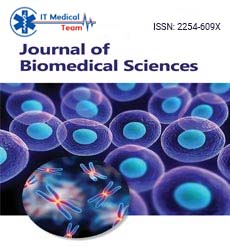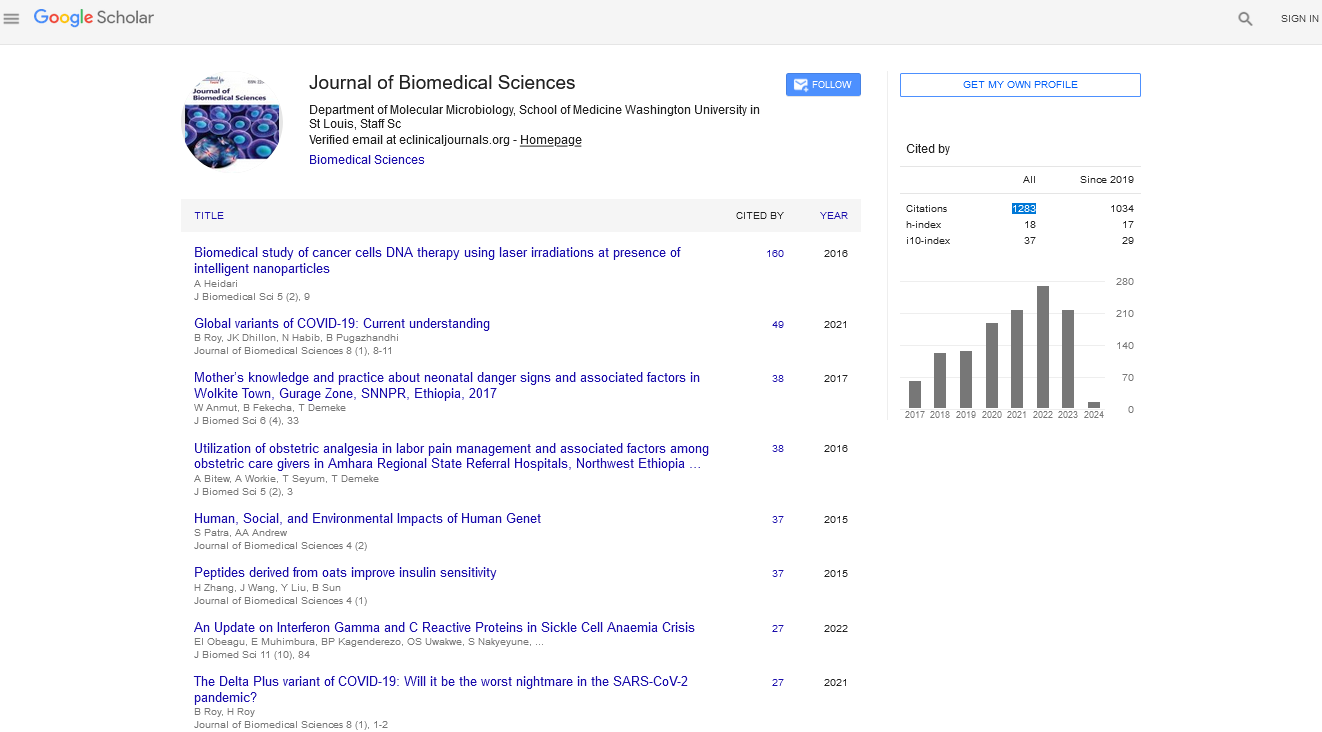Perspective - (2024) Volume 13, Issue 6
Advances in Stem Cell Therapy for Regenerative Medicine
Nicolas Garin*
Department of Cellular and Biomedical Sciences, University of Bern, Bern, Switzerland
*Correspondence:
Nicolas Garin, Department of Cellular and Biomedical Sciences, University of Bern, Bern,
Switzerland,
Email:
Received: 12-Nov-2024, Manuscript No. IPJBS-24-15312;
Editor assigned: 15-Nov-2024, Pre QC No. IPJBS-24-15312 (PQ);
Reviewed: 29-Nov-2024, QC No. IPJBS-24-15312;
Revised: 10-Dec-2024, Manuscript No. IPJBS-24-15312 (R);
Published:
17-Dec-2024
Introduction
Stem cell therapy represents a transformative frontier in
regenerative medicine, aiming to restore damaged tissues and
organs. Unlike conventional therapies, stem cell treatments
harness the body's inherent healing potential by using
specialized cells that can self-renew and differentiate into
multiple cell types. With ongoing research, this field continues to
evolve, showing promising applications in various medical areas.
This article explores the recent advances in stem cell therapy, its
therapeutic potential, challenges, and future outlook.
Description
Types of stem cells in regenerative medicine
Stem cells are broadly classified into four types: Embryonic
Stem Cells (ESCs), Adult Stem Cells (ASCs), induced Pluripotent
Stem Cells (iPSCs), and Mesenchymal Stem Cells (MSCs). Each
type offers unique advantages and faces specific challenges.
Embryonic Stem Cells (ESCs): Derived from early-stage
embryos, ESCs possess pluripotent abilities, meaning they can
differentiate into any cell type in the body. ESCs have vast
therapeutic potential; however, ethical issues and the risk of
immune rejection limit their application.
Adult Stem Cells (ASCs): Found in adult tissues, ASCs are
multipotent, meaning they can differentiate into a limited range
of cell types. Common sources include bone marrow and
adipose tissue. ASCs are widely used in regenerative medicine,
especially in treating blood-related disorders and tissue injuries,
due to their lower ethical concerns.
Induced Pluripotent Stem Cells (iPSCs): iPSCs are engineered
by reprogramming adult cells back into a pluripotent state.
These cells offer many advantages, including personalized
therapy, as they are derived from the patient’s cells, reducing
the risk of rejection. However, concerns about genetic mutations
and the efficiency of differentiation remain challenges.
Mesenchymal Stem Cells (MSCs): MSCs are multipotent cells
primarily sourced from bone marrow, adipose tissue, and
umbilical cord tissue. They possess unique anti-inflammatory properties, making them popular for treating inflammatory
diseases and injuries.
Applications of stem cell therapy
Stem cell therapy has shown considerable potential across
several medical fields, particularly in treating degenerative
diseases, tissue injuries, and chronic conditions.
Neurological disorders: Stem cell therapy offers hope for
conditions like Parkinson's disease, spinal cord injuries, and
multiple sclerosis. For example, transplanted stem cells can
replace damaged neurons and stimulate neural repair, which is
crucial for improving mobility and function in patients with
spinal cord injuries.
Cardiovascular diseases: Stem cells have been used to
regenerate damaged heart tissue following myocardial
infarctions. MSCs, in particular, are being investigated for their
potential to repair heart muscle and improve blood flow. Early
clinical trials have shown improved cardiac function; though
further research is needed to confirm these benefits.
Diabetes: For type 1 diabetes, stem cells are being explored
as a potential source for generating insulin-producing beta cells.
Researchers have successfully created beta cells from iPSCs and
ESCs, which could replace damaged cells and restore insulin
production in diabetic patients.
Musculoskeletal injuries: Stem cell therapy has been used to
treat cartilage injuries, bone fractures, and muscle
degeneration. MSCs from bone marrow or adipose tissue have
been shown to promote cartilage repair in osteoarthritis and
improve recovery in muscle injuries.
Liver diseases: Liver regeneration using stem cells is a
promising area, especially for patients with end-stage liver
disease. Researchers are developing methods to differentiate
stem cells into functional hepatocytes (liver cells) that could
replace damaged liver tissue and restore liver function.
Challenges in stem cell therapy
Despite significant advances, several challenges remain in
developing safe and effective stem cell therapies.
Ethical concerns: The use of ESCs raises ethical issues
regarding embryo destruction. While iPSCs offer an alternative, these ethical considerations continue to influence public
perception and regulatory policies.
Tumorigenicity: Stem cells, especially iPSCs, pose a risk of
forming tumors if not properly differentiated before
transplantation. Developing protocols to ensure complete
differentiation and safety is critical to prevent adverse effects.
Immune rejection: While iPSCs derived from a patient’s cells
reduce the risk of immune rejection, other stem cell types may
still elicit immune responses. Strategies like immunosuppressive
therapy or genetic modification of stem cells are being explored
to address this issue.
High costs and accessibility: The cost of stem cell therapy is
often prohibitive, limiting access for many patients. Advanced
therapies involve complex procedures and stringent
manufacturing processes, which add to the expense. Reducing
costs and improving scalability are essential for wider adoption.
Regulatory hurdles: Stem cell therapies face rigorous
regulatory scrutiny to ensure safety and efficacy. The lengthy
approval process can delay bringing new therapies to market.
Streamlined regulatory pathways that maintain safety standards
could accelerate the availability of promising treatments.
Future outlook
The future of stem cell therapy in regenerative medicine is
promising, with several trends shaping its development.
Personalized medicine: The ability to generate patientspecific
stem cells opens up possibilities for personalized
medicine. Tailoring treatments to individual genetic profiles can
improve therapeutic outcomes and reduce the risk of adverse
effects.
Combination therapies: Integrating stem cell therapy with
other treatments, such as gene therapy or immune modulation,
could enhance therapeutic efficacy. For instance, combining
MSCs with immune checkpoint inhibitors may improve
outcomes in cancer therapy.
Clinical trials and commercialization: Increasing numbers of
clinical trials are paving the way for the commercialization of
stem cell therapies. Ongoing research aims to refine protocols,
improve safety, and demonstrate long-term efficacy. As
regulatory frameworks adapt to advances in stem cell science,
more treatments could become available to patients worldwide.
Artificial Intelligence (AI) and machine learning: AI is being
used to optimize stem cell differentiation protocols, predict
patient responses, and identify new therapeutic targets.
Machine learning algorithms can analyze large datasets to
uncover insights that drive precision medicine, especially in
complex diseases like cancer and neurodegeneration.
Conclusion
Advances in stem cell therapy have opened new avenues for
treating previously incurable diseases and injuries, transforming
regenerative medicine. Despite challenges related to ethical
considerations, tumorigenicity, immune rejection, and high
costs, ongoing research and innovation hold promise for
overcoming these hurdles. As technologies like gene editing, 3D
bioprinting, and AI continue to evolve, the future of stem cell
therapy will likely see increased accessibility, improved safety,
and wider applications. This transformative field holds the
potential to redefine medicine, offering hope to millions
worldwide.
Citation: Garin N (2024) Advances in Stem Cell Therapy for Regenerative Medicine. J Biomed Sci Vol:13 No:6





